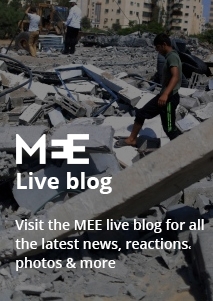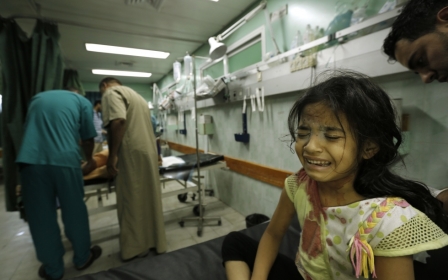Captured Israeli soldier named, deaths rise in Rafah shelling as ceasefire ends

Hospital officials now say at least 50 were killed and 200 were injured in Rafah by Israeli tank fire in south Gaza on Friday morning, as a ceasefire agreement collapsed after just three hours. The shelling came after the suspected abduction of an Israeli soldier by Hamas in the area.
AFP reported that an artillery barrage was preventing medics from recovering all dead and wounded in Rafah. Meanwhile, Israeli media wrote that the Israeli army "fears" a soldier may have been kidnapped around 9:30 a.m. in the vicinity of Rafah.
Haaretz has reported that the name of the IDF soldier suspected to have been taken is 2nd Lt. Hadar Goldin, a 23 year old from Kfar Saba. His family has been notified, noted Haaretz.
An Israeli military spokeswoman told Ma'an that she could confirm a "suspected abduction" of an Israeli soldier in the area.
The military said in a statement that at around 9:30 am, "an attack was executed against (Israeli) forces operating to decommission a tunnel."
"Initial indication suggests that an (Israeli) soldier has been abducted by terrorists during the incident."
Egypt told Palestinian officials Friday it is delaying ceasefire talks in Cairo after Israel said Hamas captured one of its soldiers in Gaza, a senior Islamic Jihad official told AFP.
Intensive Israeli shelling killed at least 35 people and wounded more than 150 Rafah, medics said, shattering a fragile truce only hours after it began.
Israeli media had reported minutes earlier that as far as Israel was concerned, a 72-hour cease-fire agreement with Hamas was now annulled.
Israel's military co-ordinator in the territories advised UN's Robert Serry of the development, a senior Israeli official told Haaretz.
Israel had accused Hamas of committing a “flagrant breach” of the Gaza truce.
The US and UN brokered humanitarian truce began at 8am (0500 GMT), after several hours of heavy Israeli bombardment in Gaza.
There were clashes between Hamas and Israeli forces throughout the early hours of Friday, across Khan Younis, Jabaliya and Shejaiya, according to MEE’s Mohammed Omer in Gaza. The fighting came after a bloody day on Thursday, when 84 people were killed including 12 members of the Bayoumi family in Nusseirat refugee camp.
The death toll in Gaza now stands at 1,459, surpassing the number killed during Israel’s deadly three week long Operation Cast Lead in 2008-9.
Five Israeli soldiers were killed in Gaza “during operational activity” early on Friday, according to a military statement. 61 troops have now been killed on the Israeli side since a ground invasion began on 17 July.
US Secretary of State John Kerry earlier said that Israeli and Palestinian representatives, including from Hamas, would begin talks over a longer term truce deal in Cairo after the ceasefire was implemented.
Kerry had said that although a three day humanitarian ceasefire had been agreed by all sides, part of the deal included permission for Israel to contine destroying Hamas tunnels in Gaza.
The Palestinian delegation was expected to arrive in Cairo on Friday, although the Israelis were due not to travel until Saturday night after the Jewish Sabbath.
It remains to be seen if the Cairo talks will be held, after the renewed outbreak of hostilities in Gaza.
When the ceasefire began on Friday morning there was much hope it would provide respite for the people of Gaza.
Palestinian doctor Belal al-Dabour tweeted: “This ceasefire should give us a glimpse on our life for the coming months after Israel destroyed everything. It’s not going to be pretty.”
More than 235,000 people, over 10 percent of Gaza’s population, have been displaced since Israel launched its offensive on 7 July, according to UNRWA spokesperson Chris Gunness. They are being housed in 86 shelters, which are each holding 2,750 people on average.
UNRWA has said that it is at breaking point.
The wholesale destruction of entire areas in Gaza has not only led to a humanitarian crisis but caused a plethora of other issues that will take some time to address.
After the enclave’s only power station was bombed earlier in the week, Gaza has been plunged into darkness, which has led to a food crisis as bakeries have been unable to operate. Gaza’s water authority says they are experiencing a water and environmental crisis as well, due to a lack of supply and damage to sanitation equipment.
A Hamas spokesperson had earlier warned the ceasefire would only last if both sides stop their fire.
“Hamas and all the resistance movements have accepted a 72-hour humanitarian ceasefire from 8am (0500 GMT) Friday which will be respected by all these movements if the other party also observes the ceasefire,” said Fawzi Barhum.
A source in the office of Israeli Prime Minister Benjamin Netanyahu told AFP: “Israel has accepted the US/UN proposal for a 72-hour humanitarian ceasefire beginning 8am (0500 GMT) Friday.”
Speaking from New Delhi in India, John Kerry expressed hope the ceasefire would hold but warned there was still much work to be done in finding a longer term agreement.
“This is a respite, a moment of opportunity - not an end. It’s not a solution,” he said, adding that Israel will still be allowed to carry out “defensive” operations to destroy tunnels.
Newly appointed British Foreign Secretary Philip Hammond welcomed talk of a humanitarian truce and called for renewed efforts to find a ceasefire deal.
“We should now redouble our efforts and leave no stone unturned to ensure this is a lasting and durable ceasefire to make way for substantial discussions to resolve the underlying issues on both sides,” he said.
Middle East Eye propose une couverture et une analyse indépendantes et incomparables du Moyen-Orient, de l’Afrique du Nord et d’autres régions du monde. Pour en savoir plus sur la reprise de ce contenu et les frais qui s’appliquent, veuillez remplir ce formulaire [en anglais]. Pour en savoir plus sur MEE, cliquez ici [en anglais].





